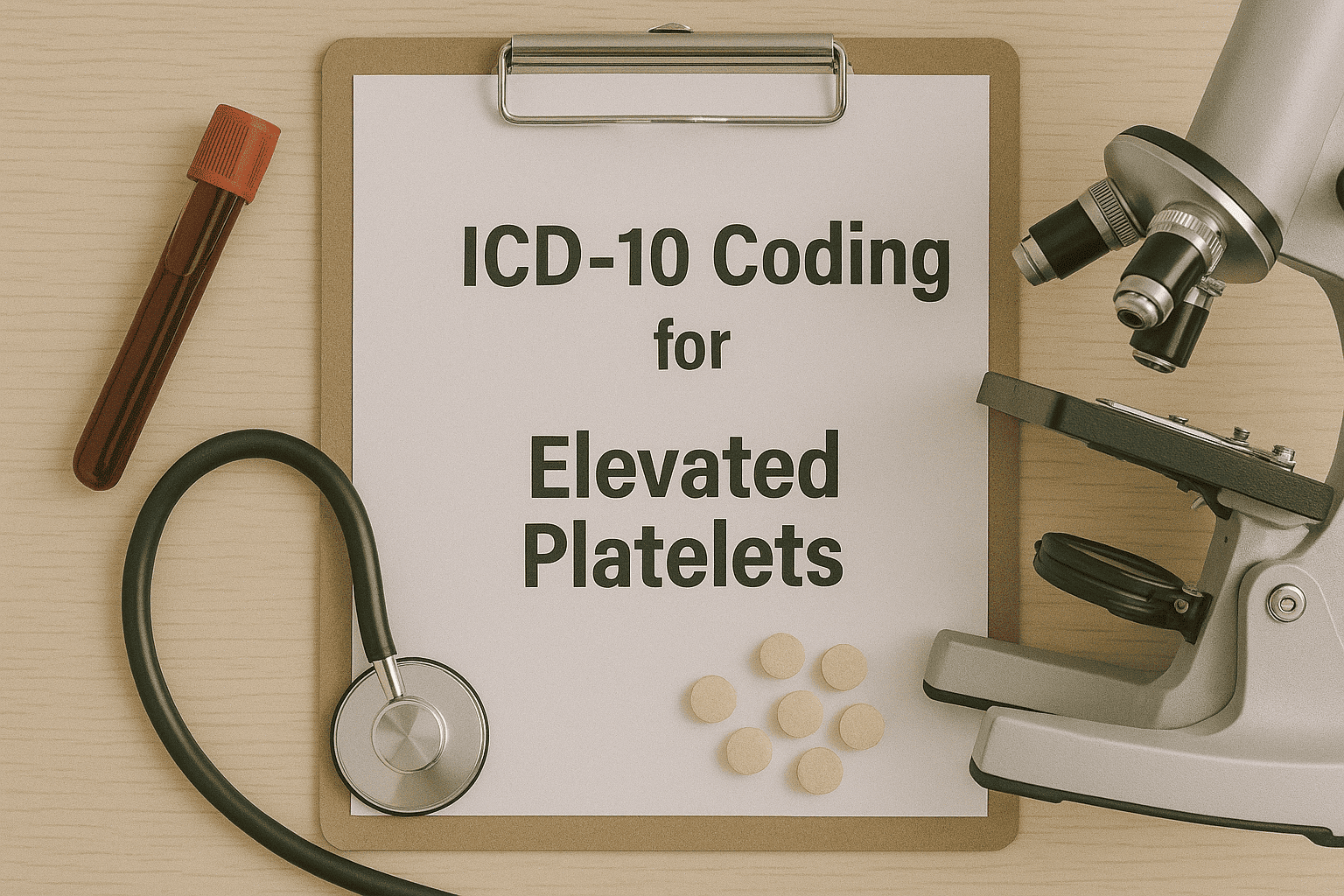Updated on: July 23, 2025
When a complete blood count (CBC) flags elevated platelets, clinicians must swiftly determine whether it’s a benign reactive process or a sign of an underlying myeloproliferative disorder. This lab anomaly, known medically as thrombocytosis, can have wide-ranging clinical implications—from post-surgical inflammation to chronic hematologic malignancies.
This guide simplifies the diagnosis, ICD-10 coding, and documentation of elevated platelet counts—and how AI-powered tools like DocScrib can streamline the entire workflow for busy clinicians.
What Are Elevated Platelets?
Platelets, or thrombocytes, are blood components that help form clots to stop bleeding. A normal platelet count ranges between 150,000–450,000/μL.
-
Elevated Platelets (Thrombocytosis): Count > 450,000/μL
-
Can be:
-
Primary (Essential) – due to bone marrow dysfunction
-
Secondary (Reactive) – in response to other conditions
-
Clinical Causes of Elevated Platelets
Reactive (Secondary) Thrombocytosis
These are non-clonal and the most common causes of elevated platelets.
| Cause | Example ICD-10 Code | Description |
|---|---|---|
| Acute infection | J18.9 | Pneumonia |
| Inflammation | K50.90 | Crohn’s disease |
| Post-surgical states | Z48.89 | Recovery after surgery |
| Iron deficiency anemia | D50.9 | Common in menstruating females |
| Splenectomy | Z90.81 | Post-surgical platelet elevation |
| Malignancy | C50.911 | Breast cancer, etc. |
Primary (Essential) Thrombocytosis
This is a clonal myeloproliferative neoplasm requiring hematologic referral.
| Condition | ICD-10 Code | Description |
|---|---|---|
| Essential thrombocythemia | D47.3 | Bone marrow disease causing high platelets |
| Polycythemia vera | D45 | Often overlaps with elevated platelets |
| Chronic myelogenous leukemia | C92.10 | May present with abnormal platelet count |
Clinical Signs and Symptoms
-
Often asymptomatic, especially in reactive cases
-
When symptomatic, patients may report:
-
Headaches or dizziness
-
Tingling in fingers/toes
-
Bruising or bleeding
-
Vascular events (rare): stroke, clot, or MI
-
🧠 Clinical Pearl: Always correlate elevated platelet count with inflammatory markers (CRP/ESR), iron studies, and peripheral smear.
ICD-10 Coding for Elevated Platelets
Accurate ICD-10 documentation helps ensure appropriate treatment, follow-up, and insurance reimbursement.
Key Codes to Know
| Description | ICD-10 Code | When to Use |
|---|---|---|
| Thrombocytosis, unspecified | D75.839 | General elevated platelet count without clear cause |
| Essential thrombocythemia | D47.3 | Primary, clonal cause (hematologic origin) |
| Secondary thrombocytosis | Use underlying cause | Reactive cases (e.g., D50.9 for iron deficiency) |
| Abnormal platelet function | D69.9 | If patient presents with bleeding/bruising symptoms |
Example Documentation Flow with DocScrib
Patient Visit:
62-year-old female with history of rheumatoid arthritis presents for routine labs. CBC shows platelet count of 620,000/μL.
DocScrib Suggests:
-
Rheumatoid Arthritis (M06.9) as primary diagnosis
-
Thrombocytosis (D75.839) as a secondary code
-
Automated SOAP Note:
vbnetS: Patient is asymptomatic, no bleeding/bruising.
O: Platelet count: 620,000/μL. ESR: 56. CRP elevated.
A: Secondary thrombocytosis likely due to active RA.
P: Continue methotrexate. Re-check CBC in 6 weeks.
Clinical Management of Thrombocytosis
Reactive Thrombocytosis
-
Treat the underlying cause (infection, inflammation, IDA)
-
Antiplatelet therapy rarely indicated unless vascular risk is high
Essential Thrombocythemia
-
Referral to hematology
-
Cytoreductive therapy (e.g., hydroxyurea)
-
Low-dose aspirin for thromboembolism prevention
How DocScrib Streamlines Your Workflow
Whether you’re in primary care, hematology, or inpatient medicine, documentation fatigue is real. That’s where DocScrib steps in to transform your experience.
| Feature | Traditional Workflow | With DocScrib |
|---|---|---|
| Manual ICD-10 Lookup | ⛔ Time-consuming | ✅ Auto-suggested based on labs & HPI |
| Note Generation | ⛔ Typed manually in EHR | ✅ 1-click SOAP or narrative summary |
| Billing Code Accuracy | ⛔ Missed secondary codes | ✅ Dual-code suggestion feature |
| Lab Result Interpretation Notes | ⛔ No auto-integration | ✅ Auto-linked to diagnostic note |
| Reimbursement Denials | ⛔ More frequent | ✅ Minimized with precise coding |
FAQs: Elevated Platelets & Coding
Q1: Should I always code D75.839 for elevated platelets?
Not necessarily. Use it when thrombocytosis is unexplained. Otherwise, code the underlying cause.
Q2: Is elevated platelet count dangerous?
It can be, especially in primary thrombocytosis, which increases the risk of clotting and bleeding. Always evaluate the patient context.
Q3: How often should I recheck CBC in thrombocytosis?
-
Reactive: Every 4–8 weeks until normalization
-
Essential: Per hematologist recommendation, usually every 1–3 months
Q4: Can AI assist in hematology documentation?
Yes! Tools like DocScrib interpret labs, recommend ICD-10 codes, and generate notes in real-time.
Final Thoughts: From Platelets to Precision
Elevated platelet counts aren’t just a number on a lab report—they’re a clinical clue. Distinguishing between reactive and primary thrombocytosis can shape the entire care pathway. And when every ICD-10 code and SOAP note matters for care quality and compliance, why not make it easier?
DocScrib empowers clinicians to:
-
Cut documentation time by 70%
-
Increase billing code accuracy
-
Deliver structured, compliant notes
-
Stay focused on patient care, not paperwork
🔗 Visit DocScrib.com
📞 Schedule a Demo Today and see how DocScrib fits into your workflow.
